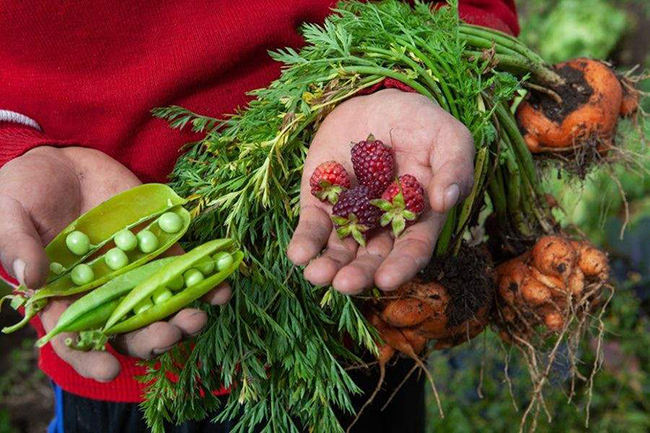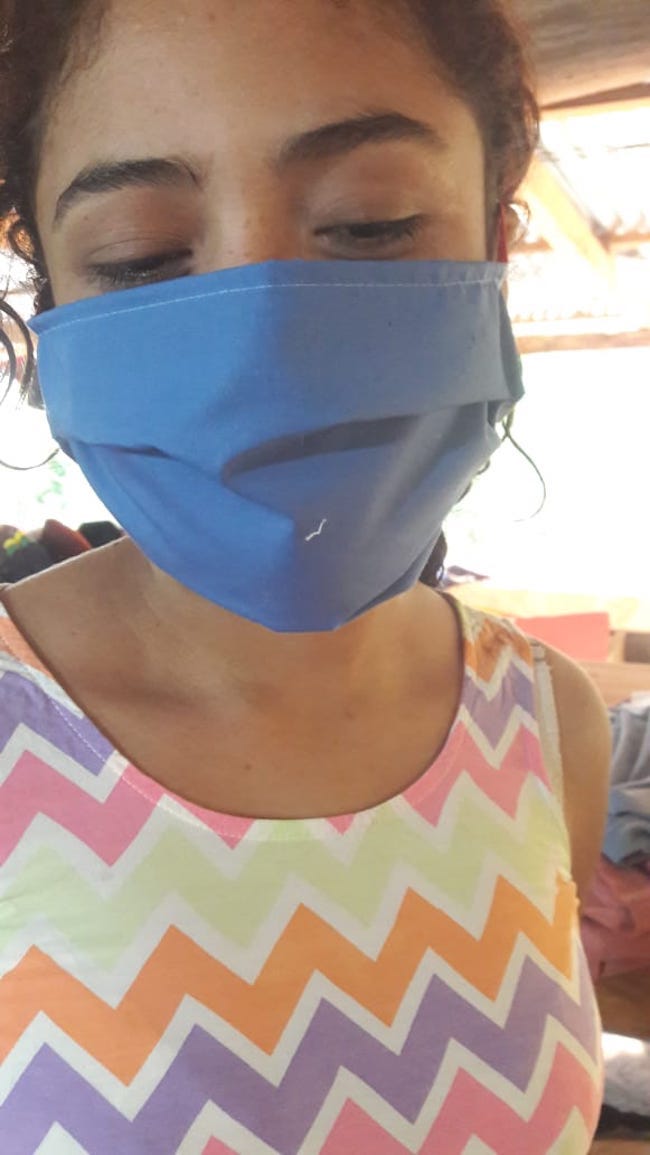
Heifer International
This content was written by Heifer International, and paid for by Heifer International; it was not written by and does not necessarily reflect the views of Mother Jones' editorial staff. See our advertising guidelines to learn more.
There was no way for small-scale farmers and seafood harvesters in Ecuador to anticipate the COVID-19 pandemic more than a year ago when they started diversifying the products they grew and mapping efficient paths to get them to hungry urban markets. But when the coronavirus hit this South American nation hard, these farmers found themselves well-prepared to keep homebound customers fed. Working with Heifer International, they created a whole new system on the fly, putting out catalogs of their offerings, adopting stringent sanitation practices on farms and in production facilities, and partnering with an app developer so urban customers could use smartphones to easily order fresh produce directly from rural farms.
“We are quite busy, working around the clock, preparing baskets filled with produce that will be delivered at people’s homes, and it’s a hard task. We help farmers sell their produce and we help supply the city with produce,” said Nelson Pamar, the president of Pamar Chacrin, one of the farmers groups working with Heifer International as part of the Future of Food project. The project kicked off in 2019 to boost the production of nutritious, sustainably grown food and get it to eager urban customers.
In Ecuador, rural farmers are working together to get fresh food to urban customers. Heifer International
Their business model looked quite different a few months ago when member farmers sold their produce in open-air marketplaces and fairs.
“When the health emergency was announced, we no longer had anywhere to sell our food, and we were worried, but we didn’t just cross our arms—immediately, we organized to deliver baskets containing grains and beans, vegetables, quinoa, and bok choy at our customers’ homes,” Pamar said.
When public urban transportation systems came to a standstill, farmers took to delivering baskets of vegetables, grains, and beans by bicycle, if not by well-sanitized vehicles. In doing so, the farmers protected their own livelihoods in a time of economic crisis, when larger-scale food supply chains were broken.
They also received additional training and improved guidelines on biosafety and food-handling protocols. Created in collaboration with Simón Bolívar Andean University, Ecuador’s Andina EcoSaludable program, these guidelines outline how to safely handle food during harvest and post-harvest, and package it amid pandemic concerns.
“We have always treated food carefully, but now we are even more careful with the details,” said Rosa Mena, a member of the Pamba Mikuna agro-producers group whose own land is located on the outskirts of Quito, Ecuador.
Stringent new sanitation guidelines protect the quality and cleanliness of food as it travels from farm to table. Heifer International
This is the first time many customers are giving more than a second thought to the people who grow their food, said Rosa Rodriguez, country director for Heifer Ecuador. “This crisis showed us that food producers are first responders, just like doctors and nurses, because they guarantee people’s health by delivering nutritious and safe food,” she said.
“This crisis has meant that now small farmers and organic produce are valued,” said Margarita Haro of the El Marco Agricultural Cooperative, which is based in the parish of Píntag and supplies fresh food to some of Ecuador’s fast-growing urban areas, including Conocoto and Sangolquí. “When we deliver our products, people tell us we are just as important as doctors who are working nonstop in hospitals while we deliver their food.”
Helping small-scale farmers and business owners weather the unexpected is part of Heifer’s projects across the world, and we’ve seen their resilience on display over the years in the wake of earthquakes, typhoons, and other natural disasters. The COVID-19 outbreak is again putting farmers’ resilience to the test, forcing them to find creative ways to protect their livelihoods and the health of their communities. Project participants in Nepal proved up to the challenge in recent months, when men and women trained to provide vaccines and other basic care to animals kept working to keep livestock healthy while state-run and private veterinary clinics were closed. In Bangladesh, Heifer farmers are selling their produce to a wholesaler whose urban clients otherwise couldn’t find fresh food.
In Honduras, Heifer-partnered cooperatives of coffee farmers and beekeepers have played a slightly different role in the COVID-19 response. Having strengthened themselves over the years to withstand an economic dry spell, these farmers were in the position to temporarily put profit-making aside and pass on gifts of care to their neighbors. Some cooperative members grew, roasted, ground, and packed 8-ounce sachets of high-quality coffee to include in “solidarity” bags for people in need. These packages, which also contain fresh food in addition to coffee provided by Heifer farmers, are expected to reach over 2,000 families left vulnerable in the coronavirus pandemic. Beekeepers put together care packages of cleaning supplies and non-perishable foods including pasta, tomato paste, rice, coffee, sugar, corn flour, shortening, oats and bottles of honey.
Farmers in Ecuador figured out how to get fresh produce to their customers despite obstacles brought on by the pandemic. Heifer International
While we celebrate successes like these, Heifer International and other hunger relief organizations are scrambling to help the millions of people who haven’t been as lucky. In India, for example, the near certainty of going broke and hungry during a countrywide lockdown seemed more ominous to many of the country’s poor than the possibility of contracting the novel coronavirus. Those worries grew as government-funded community kitchens struggled to meet demand.
And the suffering brought on by COVID-19 is expected to worsen. The novel coronavirus has killed more than 400,200 people around the world, with food supply chain breakdowns and paralyzed economies compounding the misery. Enough food exists to feed everyone, says Arif Husain, chief economist and director of research, assessment, and monitoring for the United Nations World Food Programme. But that food is not getting to where it’s needed, and more people are falling into acute hunger, meaning their situations changed suddenly from relative stability to a chronic lack of food. What’s more, the number of people suffering from acute hunger in low- and middle-income countries is expected to nearly double by the end of 2020, going from 135 million to 265 million.
Hunger and poverty result from our global pandemic, but they’re also part of the cause. Close quarters, preexisting malnutrition, immunosuppressive conditions, and lack of access to good health care or sanitation facilities are a recipe for spreading disease. Reducing poverty worldwide could do much to reduce the spread of pandemics. Investments in sanitation, clean water systems, and public health infrastructure pay off well in protecting the health of not just the poor, but everyone.
Heifer project participants in Nicaragua stepped up to make masks for their neighbors. Heifer International
Watching the resilience of Heifer farmers and project participants pay off in the face of COVID-19 underscores the urgency of lending a hand to more small-scale farmers and business owners. Pandemics aren’t going away. They are likely to continue emerging while becoming much more severe. COVID-19 is another in a series of dangerous diseases in recent memory: Ebola, Zika, H1N1, SARS to name a few. The world’s escalating interconnectedness through technology, ease of travel, and economic systems means that infections can spread farther and faster than ever before. Climate change and displacement exacerbate the impact, and many countries are woefully unprepared to deal with these events.
Recovery from this pandemic demands myriad fixes on multiple fronts. The good news is that we all have a straightforward role to play. Working together for the common good protects rich and poor, urban and rural, young and old. Our mission at Heifer International is to help small-scale farmers and food producers build stability and scale up production and distribution so that we can all meet today’s challenges and the challenges ahead.
We have something to ask. For the families Heifer International serves, this new and changing reality could mean not being able to earn money or feed their children. Help us give these families a boost by giving today.
